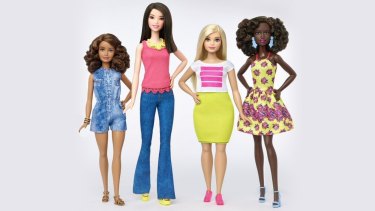You can buy a child a curvy Barbie doll, but you can’t make her play with it. This is the finding of a recent survey, which found that girls as young as 3 were rejecting the curvy doll in favour of the traditional, skeletal one.
It also puts a hole in the argument that if only children were given exposure to more “body diverse” toys, they would play with them.
Young girls are rejecting ‘curvy’ Barbies; they see a single body type still reflected as ‘ideal’.
Barbie, who first lined the shelves of toy stores in 1959, has long been a symbol of the narrow confines of female body image. The doll has enjoyed occupations as diverse as astronaut, (in 1965) and palaeontologist, (in 1997) but has remained at the same weight and height for 57 of her 60 years.
If Barbie were a human woman, she’d be 5’9 or 175 cm and weigh 49 kg – we know this because one of Barbie’s accessories was her own set of scales that were set permanently at 110 pounds with a cup size FF. This made Barbie in real terms around 17 kg underweight. Researchers have previously stated that she would not have enough body fat to menstruate.
While Mattel has sold over a billion Barbie dolls over the years, in 2014, sales began to sharply decline. The solution, Mattel decided, was to diversify, a welcome move from body image advocates. In 2016 they released three optional body shapes – petite, tall and curvy – as well as seven different skin tones.
Research indicates that weight or shape bias can start as early as 5 years-old and sometimes younger.
Alas, it appears to have been in vain for the girls surveyed who were aged between 3 and 10, who said the curvy Barbie was the one they least wanted to play with. Less surprising was the finding that girls with greater body dissatisfaction preferred the thin Barbie.
“It’s not surprising that girls as young as three are rejecting ‘curvy’ Barbie” says Amelia Trinick, clinician and team leader of the national helpline at the Butterfly Foundation. “Research indicates that weight or shape bias can start as early as 5 years-old and sometimes younger.
“For girls, puberty is regarded as the greatest risk period for the onset of body image issues and the development of eating disorders. However, negative thoughts or feelings in regards to one’s body can be internalised from a very young age.”
The reasons, of course, though complex, are connected to our culture’s elevation of one particular body type over others. Research has shown that the more we are exposed to one particular body type, no matter how unattainable or rare, the faster we normalise this body type in our minds, rendering other bodies not just uninspiring but distasteful.
It makes sense then, that if children can recognise and identify brands such as McDonalds and Kleenex before they are five, (a fact proven two decades ago) they can also recognise a dominant body type, ie a tall, underweight woman, and eventually come to prefer it.
“Over-exposure to ‘ideal’ bodies represented in the media may potentially trigger body dissatisfaction from a young age, which could potentially translate into dangerous behaviours and in some cases, eating disorders later in life” says Trinick. “Advertisers and the media have a social duty of care to be more diverse in their portrayal of body shapes and sizes.”
But there is one component missing from this equation, and it might be the most significant: the role of parents. Children, especially very young children, model what they see and hear, so it’s on caregivers to create an environment of body acceptance.
“Be mindful of your language at home,” advises Trinick. “Refrain from labelling foods or appearance as ‘good’ or ‘bad’. And speak kindly about yourself, avoid negative self-talk; children pick up on these messages and will often apply them to their own bodies or appearance. Compliment or acknowledge children for their actions or behaviours, rather than having a focus on their appearance.”
And it’s this last part of Trinick’s advice that might hold the key to the Barbie problem. Because, let’s face it, when kids play with Barbies, they’re not testing out new ways of flying to the moon. Barbie is about dress ups and role play, (and that includes sex).
Trinick tells me that the Butterfly Foundation welcomes the idea of “Curvy Barbie”. But if Barbie is a chance to act out only decorative aspects of the feminine, should we be surprised that the only mode through which young girls are willing to play these out is via an unrealistic model? Barbie can not talk, she can not think, she might have a stethoscope, or a jet pack, but she ultimately exists to be dressed and undressed.
Perhaps the solution then, might be to embrace not ‘diverse’ Barbie, but the fact that declining sales mean Barbie as a concept is obsolete. It might be more beneficial, then, to discard Barbie – in all her incarnations – and play with something else entirely.
Butterfly National Helpline: 1800 ED HOPE (1800 33 4673)
Source: Read Full Article



